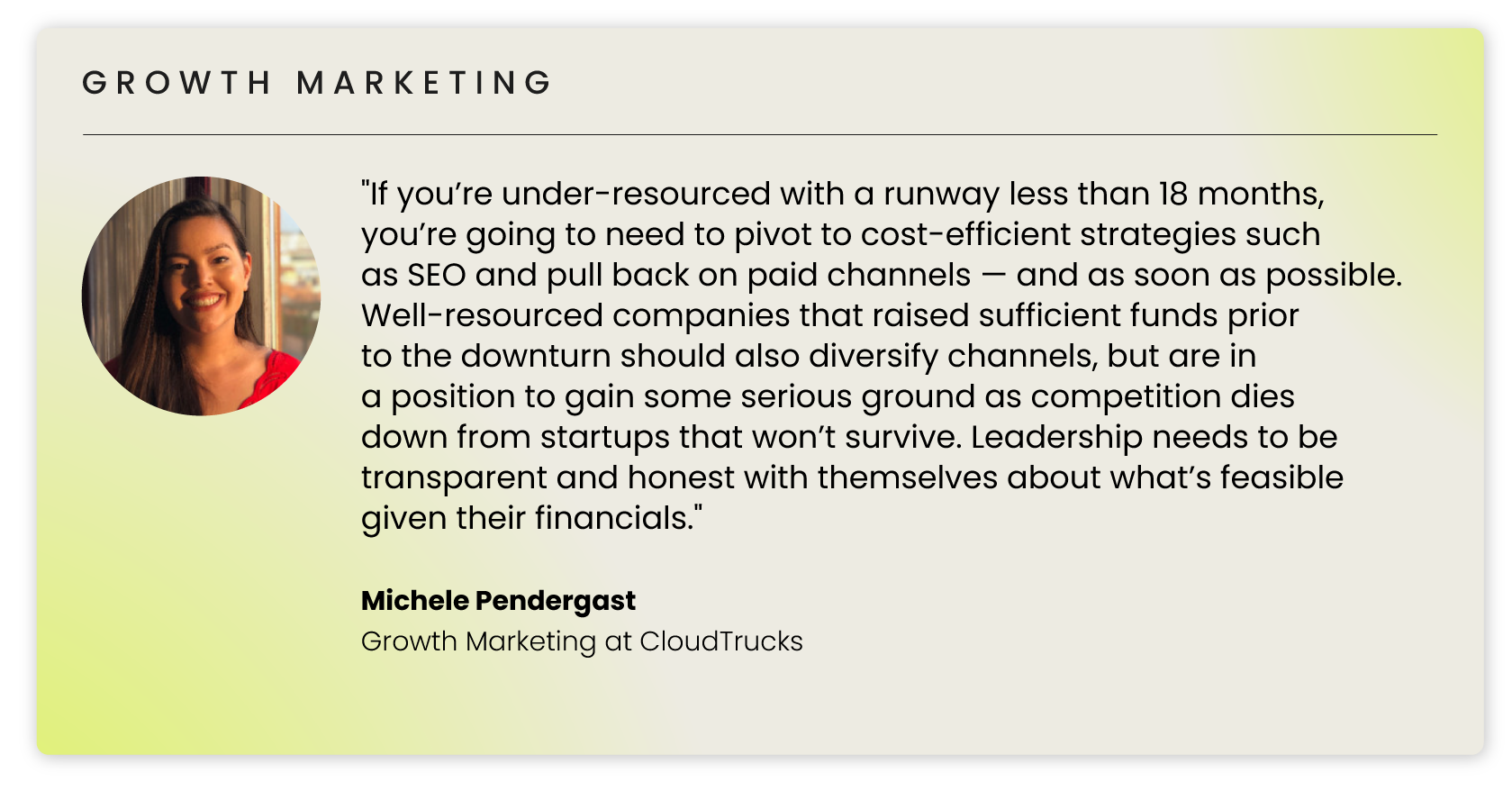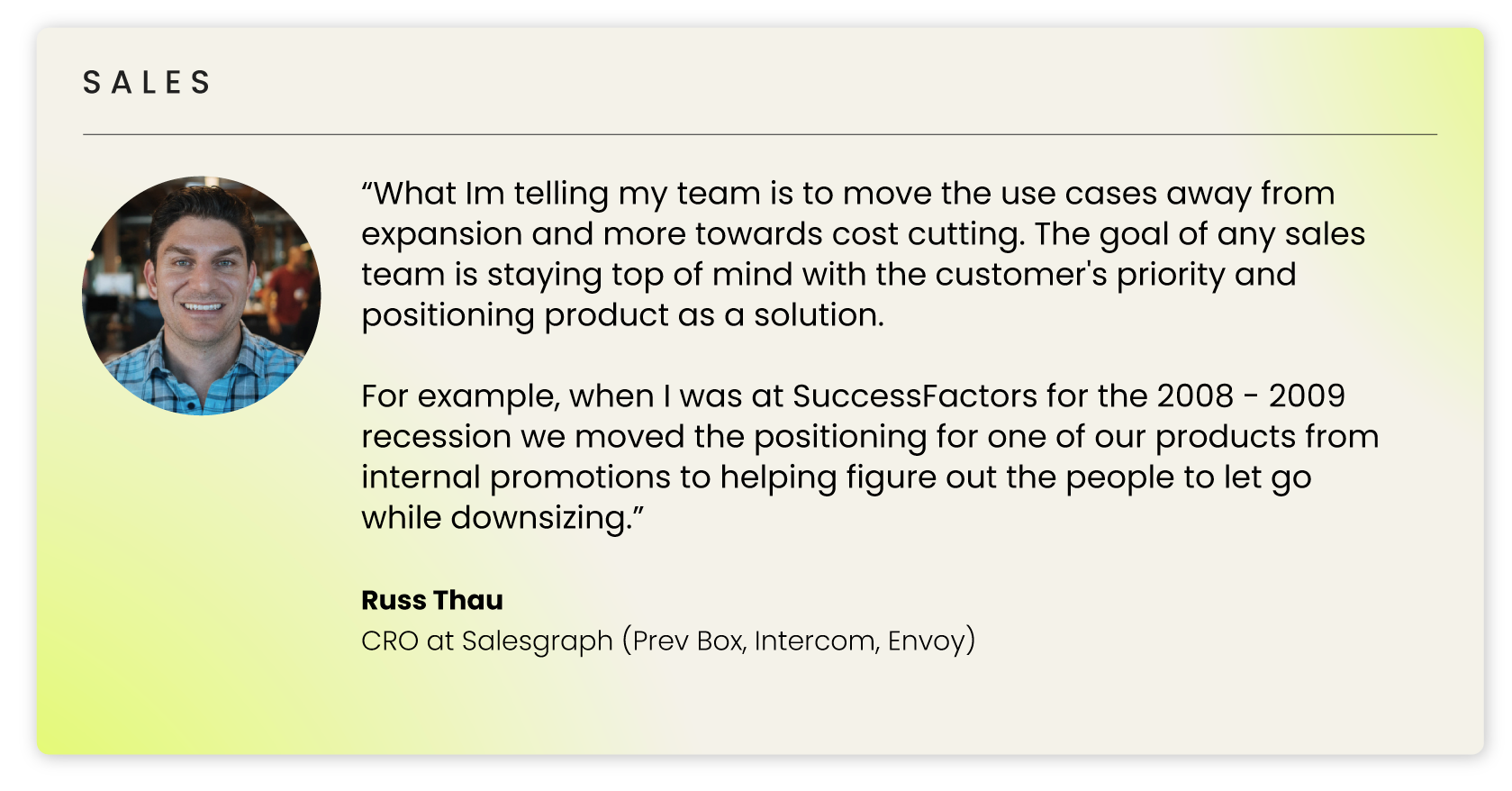How to grow during a downturn: marketing strategy for lean startups
This was originally published in our monthly newsletter. Subscribe here.
VCs and advisors are recommending drastic cuts in spending to extend runway and be default alive for the next 2 years. You’ll need to work smarter than ever in marketing in sales to get more customers. So what should your lean marketing strategy be to keep acquiring customers?
TL;DR — summary recommendations for lean marketing:
Trim sales and marketing spend that’s not immediately measurable with near-term ROI
Pivot away from boondoggles that feel good but don’t drive revenue (splashy live product launches, expensive conference sponsorships) to authentic campaigns
Make sure your existing customers are thrilled with your product and are getting the most value they can to decrease churn
Invest in low cash spend activities with long term ROI like improving website conversions and SEO, stronger positioning & messaging, and writing blog posts
Empower employees to do personal branding & marketing for your company
Where we are now is not looking good
The Techcrunch article summarizing YC’s message to founders says everyone should plan for the worst. David Sacks of Craft Ventures made their meeting with founders available on YouTube and the predictions are sobering.
General recommendations are to slash spending (including big layoffs) and extend your cash runway to at least 2 years or more so you can default survive.
Lean marketing tactics during a downturn
So how should you spend the little time and money you have on marketing? Trim sales and marketing spend that’s not immediately measurable with near-term ROI. Obviously, there will be differences across industries and companies, but a few examples that come to mind:
Avoid boondoggles and activities that give emotional ROI but not revenue ROI. Hosting a splashy live event for your next product launch or sending everyone to Dreamforce might be energizing and fun, but it’s possible the feeling of success is more vanity than driving actual revenue. That Sales Kick-Off in Vegas might need to wait.
We asked a few GTM experts in sales and marketing how they are pivoting their strategy. Here’s what Michele Pendergast, Alexandra Cote, Jennifer Kutz, Russ Thau, and Emily Parcell had to say:





Our team put our heads together to share specific ideas for pivoting your marketing spend and tactics to stay lean while still acquiring customers:
Vision in bull markets, operators in bears
Strong operators and tight capital allocation are critical. Grandiose visions and big ideas sputter if they don’t have the teeth to execute well. Big valuations mean nothing if you can’t grow with reasonable burn multiples (Exhibit A: Fast)
Sponsoring a booth at a conference and having lots of great convos but no tracking system to follow up with leads wastes money and time in a good economy. Now there’s no room for it. Every marketing activity must be tightly executed to ensure you squeeze every conversion you can.
Reality is your friend
Get real about which marketing tactics are working and which aren’t. If you don’t have solid tracking and analytics in place, fix that now.
Pause and take time to question everything. Host an audit session to analyze what you should start, stop, and continue doing. What made sense last quarter might not now. It’s ok to review and redirect. If your team understands the “why”, they will be able to solve the “what” and “how”.
Avoid busywork that feels productive but has minimal impact
“The first rule of prioritization: No snacking” on Inside Intercom
Avoid “snacking” — activities that are urgent but not important. Ruthlessly focus on impact.
Get a strong handle on SaaS metrics and marketing analytics
Cash burn, Customer Acquisition Cost (CAC), Churn, and Return on Ad Spend (ROAS) are all important to understanding how your marketing efforts are performing. The devil is in the details, and having strong business and operating fundamentals is key.
Make sure your existing customers are thrilled with your product
It’s cheaper to keep a customer than find new ones. Double down on new customer onboarding and new feature education to make sure your existing customers are getting all the value they can from your offering. Do random acts of delight and ensure customer support is providing fast, friendly, and reliable support.
Spend more time with your existing customers. Dig into potential content creation, co-marketing, and cross-promotion with current customers who are already your champions. Double down on activities like this that are cash-free, plus take time to learn more about why clients will stay with you even in a downturn.
Pivot campaigns from expensive and splashy to authentic and “grassroots”
Inject authenticity into your campaigns to make your brand feel more human. Spend more time on positioning, messaging, and storytelling. Spend less time on fancy animations. An authentic product demo from the founder in a Loom video can be just as effective (if not more!) than expensive animated illustrations as long as the problem, solution, and differentiation are clearly articulated.
Bobby Pinero, co-founder of Equals has a great product demo:
Invest in low cash activities with long-term ROI
Brand building through blog posts, thought leadership on social, and giving talks aren’t cash-intensive activities. If you can afford to invest the time, these tactics will make an impact now and have a long-tail ROI by improving SEO, brand recognition, and trust. Pour some coffee and turn on some focus tunes and host a short content creation hackathon. You might be surprised who the dark horse content creators are on your team.
Be sure that any content you do create gets ample distribution. Publishing a blog post and posting about it once on social isn’t enough. Make sure you’re slicing that content up and sharing often.
Empower employees to be a voice for your company on social media
People are more likely to engage with other people, not brands. Help your team improve their social profiles, give them a content inspiration calendar, help them write copy, and provide them with branded Figma or Canva templates to make their own visuals.
Revisit foundational strategies like positioning & messaging
Revisit foundational strategies like positioning & messaging is sometimes an afterthought at companies when they're focused on quick growth and ad spending. When things are "quieter" it's a good time to regroup, and refocus on these foundational things like your positioning, messaging, and product story.
From Emily: This also can apply from the design perspective... if you can, it's a great time to invest in research + discovering opportunities, and then laying the groundwork to be ready to execute on those quickly when times are better... it will give you a leg up on the competition.
Cleanup website performance and SEO
Get the most out of every website visitor by doing a website audit. Have you optimized your site for performance? Are there low-hanging opportunities to improve your SEO with better keywords in your website copy? Use Hubspot’s Free Website Grader to see if there are obvious areas you can improve.
Test your website messaging and sign up flow
Ask friends in your network to navigate your website while you watch or use Wynter to see how your target audience reacts to your messaging.
Review your processes and automate everything you can
Are you doing manual work frequently for your marketing operations? Check out Zapier or explore integrations with your existing tech stack that you might not have bothered to look into before. Are you spending time pulling reports for stakeholders across the company? Set up a dashboard so people can self-serve.
Make your team feel supported, but share the realities with them
People don’t do their best work if they fear a layoff or if morale is down. Help everyone understand that market conditions are tough right now, and it’s more important than ever to stay focused and do great work on the right work. Set clear milestones and incentives, then reward accordingly.
Recessions are a stressful time for people personally and professionally. Check-in with your team so you can understand their situation. If a partner or family member was laid off, that can create a lot of pressure and impact work performance. Check-in during 1:1s and give space for people to share what’s going on outside of their immediate work responsibilities.
Team offsites are a great way to build trust, get aligned, and build energy for the trials ahead. Doesn’t have to be expensive! Quality time together over a simple breakfast, brainstorming with pen and paper, then going on a scenic walk or hike can go a long way.
Be innovative, and if you can afford it, be aggressive
During the last downturn cycle in early 2020 when COVID hit and a bunch of clients I thought would close backed out, I had a lot of time on my hands. I took the opportunity to build The Founder’s Marketing Playbook and advise for Momentum in the form of sweat equity. Both of those investments are doing well — proof that good business can still happen in a recession.
When your competitors are taking their foot off the gas with layoffs, decreased ad spend, slowing content engine, etc., it’s a great time to be aggressive. Hire top talent that was recently laid off and bid on keywords that are now cheaper. Just like buying real estate and stocks at a discount while everyone else is licking their wounds, you can make big strides during a recession if you have the resources and the willpower to weather the storm.
Access top marketing leaders, strategies, and frameworks at a fraction of the cost of an agency of full-time hire with Olivine Marketplace or do it yourself with Olivine Playbooks.








